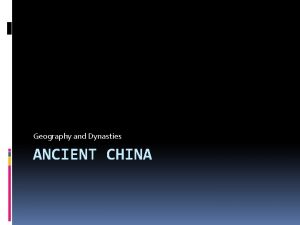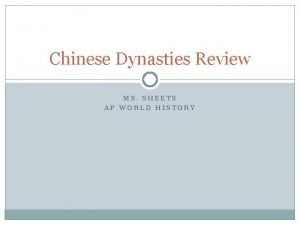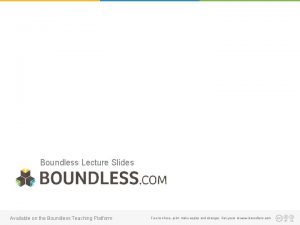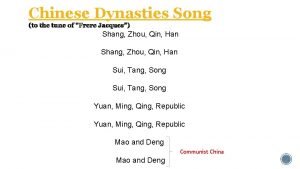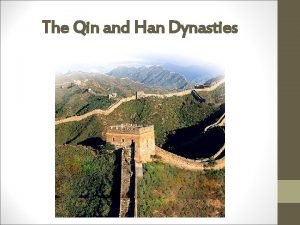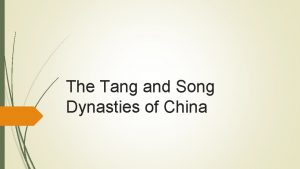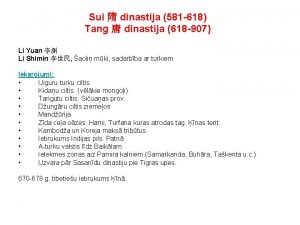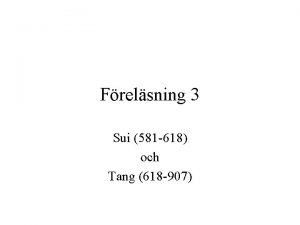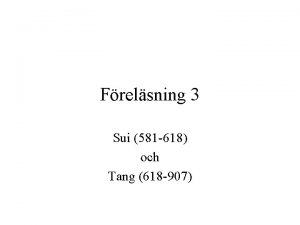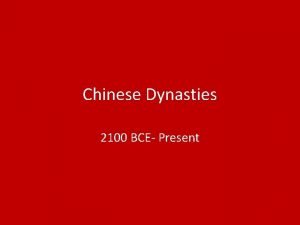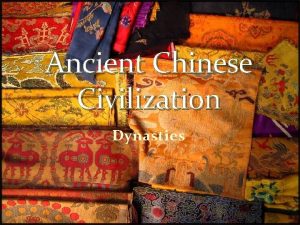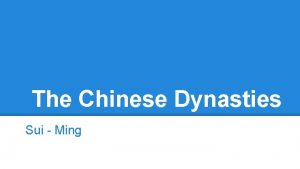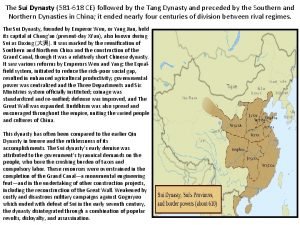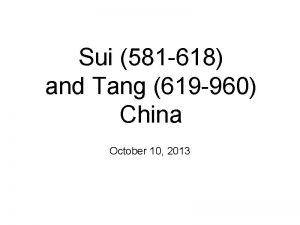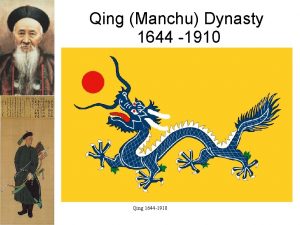CHINESE DYNASTIES From 581 1644 Sui 581 618
















- Slides: 16

CHINESE DYNASTIES From 581 - 1644

Sui (581 - 618 CE) • Completed Grand Canal • High taxes, forced labor • Made repairs on the Great Wall of China • Rebels assassinated the Emperor


Tang (618 - 907 CE) • Golden Age of China: Richest, most powerful country in the world. • Rebuilt bureaucracy – Examination system – Confucian education – Limited social mobility • Buddhism supported, then oppressed • Invention of movable print, porcelain, gun powder

Tang Dynasty (618 -918) Empress Wu – (649 -705) • Wu Zetian became the first and only woman to be Emperor – supported Buddhism. • Began a campaign to elevate the position of women. Said that the ideal ruler was one who ruled like a mother does over her children. • Meritocracy - Civil Service examsbest people ran the government and were treated fairly. Empress Wu • Reduced the army's size and stopped the influence of aristocratic military men. • Fairness to peasants- lowering

The Golden Age Artistic, Technological and Industrial Developments Gunpowder and Rockets Porcelain Chinaware Moveable Type Chinese junks Landscape art


Tang (618 - 907 CE) Decline • Weak emperors, nomadic incursions, economic difficulties • Warlords take control

Song (969 - 1279 CE) • Large centralized bureaucracy (Neo. Confucian) • Mercantile class grows, increased trade – silk and porcelain are big exports. • Magnetic compass, paper currency, growing sea power • Weak military

Song Dynasty (960 -1279) Economic System: • Rise of the Merchant • The basic unit of payment was copper coins strung on a string, but these were heavy and cumbersome for use in large-scale transactions. The Song solution was to print paper money Agricultural Advancements: • New developments in rice cultivation, especially the introduction of new strains from what is now Central Vietnam, spectacularly increased rice yields. Paper Money



Yuan (1279 - 1368 CE) • Mongol Khubilai Khan conquers China • Economic stability and prosperity • China more open to trade and travel (Marco Polo) • Ignored Chinese traditions, replaced bureaucrats with non-Chinese • Unsuccessful attacks on Japan, corruption weakens dynasty • Peasant rebellion ends Yuan


Ming (1368 - 1644 CE) • Tried to erase all signs of Mongols • Reinstated civil service, Confucian scholars • Eunuchs play growing role - resented by scholar gentry • Rebuilt and extended Great Wall and built the Forbidden City. • Distant overseas exploration…(Zheng He) • Collapsed after famines and riots

 How did the sui and tang dynasties reunite china
How did the sui and tang dynasties reunite china Period of disunion
Period of disunion Song
Song Sui tang and song dynasties
Sui tang and song dynasties Where was the sui dynasty located
Where was the sui dynasty located Chinese dynastys
Chinese dynastys Ap world history chinese dynasties
Ap world history chinese dynasties China history timeline
China history timeline Water clocks han dynasty
Water clocks han dynasty Chinese dynasties
Chinese dynasties Shang zhou qin han song
Shang zhou qin han song Four chinese dynasties
Four chinese dynasties Chinese dynasties
Chinese dynasties Admixtures
Admixtures Anglo chinese primary
Anglo chinese primary Sui dynasty grand canal
Sui dynasty grand canal 1 618 fibonacci
1 618 fibonacci





